
ARE YOU OF LEGAL VAPE AGE?
Please confirm that you are of legal age to purchase vaping products to access our site.

Please confirm that you are of legal age to purchase vaping products to access our site.
Some items are no longer available. Your cart has been updated.
This discount code cannot be used in conjunction with other promotional or discounted offer.
To investigate the aroma-contributing components in apple-flavored e-liquids, direct injection combined with gas chromatography-mass spectrometry (GC-MS) was employed to analyze the volatile components in three apple-flavored e-liquid samples. The results identified a total of 74 volatile components across the three samples: Sample A contained 45 components, Sample B contained 49, and Sample C contained 44. Twenty-four components were common to all three samples. Sample A had 7 unique components, Sample B had 14, and Sample C had 9. Sensory evaluation ranked the samples as B > A > C. Through formulation experiments, a novel e-liquid with a fresh green apple natural aroma was successfully developed.
The Vape industry has experienced rapid growth in recent years, offering a diverse range of e-liquid flavor profiles that significantly expand beyond the limitations of traditional cigarette aromas. Fruit-flavored Vape products, in particular, have gained immense popularity among consumers. Apples, as one of the most typical, common, and beloved fruits worldwide, impart aromas characterized by freshness, sweet-sour notes, fragrance, and richness. While extensive research exists on the aroma compounds in apple fruits, studies on the composition of apple-flavored e-liquids remain scarce both domestically and internationally. This study conducts a comparative analysis of the volatile components in apple-flavored e-liquids from three different brands and companies, and develops a novel apple-flavored e-liquid. The findings aim to provide reference data for the development and formulation of fresh fruit-flavored e-liquid products.
Materials
Three apple-flavored e-liquid samples (A, B, and C) from different brands and companies were purchased from the market in 2023.
Instruments and Equipment
Agilent 5977B gas chromatograph-mass spectrometer (USA) and Agilent 7890B gas chromatograph (USA).
Sample Preparation and Analysis
A 0.8 μL aliquot of each e-liquid sample was directly injected for analysis, following the method described by Han Xiaozhe. Chromatographic conditions: HP-5MS column (60 m × 0.25 mm × 0.25 μm); injector temperature: 250°C; column head pressure: 58 kPa; split ratio: 40:1; temperature program: initial temperature 50°C, ramped at 4°C/min to 250°C, held for 10 min. Mass spectrometry conditions: EI source, electron energy 70 eV, electron multiplier voltage 1800 V, mass scan range 33–250 amu; ion source temperature 230°C; transfer line temperature 280°C; NIST11 library search.
Qualitative and Quantitative Analysis
Compounds were identified via NIST library search combined with manual mass spectrum interpretation. Relative content of each component was calculated using peak area normalization (percentage of peak area).
Sensory Evaluation Analysis
Sensory evaluation was conducted by the Vape evaluation panel at Shenzhen Boton Flavors Co., Ltd., using a 9-point scoring system across eight indicators: aroma quality, aroma quantity, off-notes, concentration, throat hit, irritation, sweetness, and aftertaste.
Qualitative Analysis of Volatile Components in Three Apple-Flavored E-Liquids
GC-MS analysis of the three apple-flavored e-liquids yielded total ion chromatograms, as shown in Figure 1. Compounds with similarity scores above 80% from the NIST standard library were selected for qualitative identification. Using peak area normalization, a total of 74 volatile components were identified (Table 1). Sample A had 45 compounds, Sample B had 49, and Sample C had 44. The identified compounds accounted for 99.886%, 99.343%, and 99.661% of the total volatile peak areas in Samples A, B, and C, respectively.
Figure 1 GC-MS total ion chromatograms of volatile components in three apple-flavored e-cigarette liquids
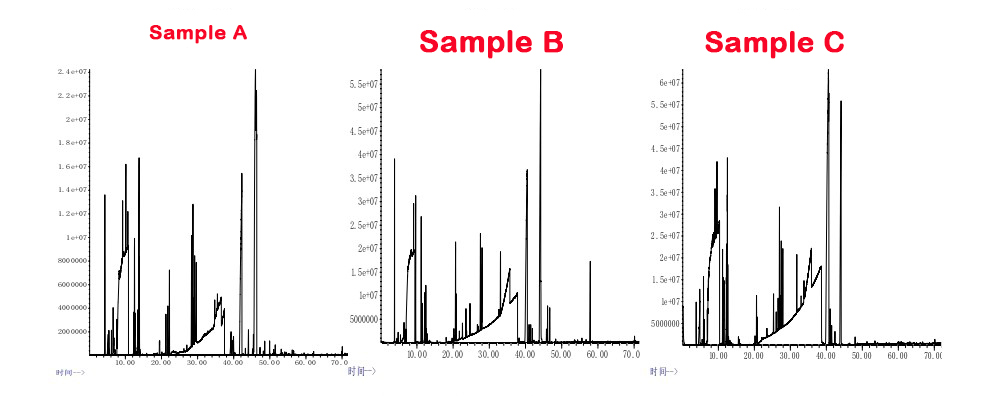
Comparative Analysis of Volatile Components in Three Apple-Flavored E-Liquids
As shown in Table 1, the three e-liquids shared 24 common components (including trace amounts): ethanol, ethyl acetate, acetic acid, butanol, acetaldehyde propylene glycol acetal, ethyl butyrate, propylene glycol, butyl acetate, ethyl 2-methylbutyrate, leaf alcohol, trans-2-hexenol, hexanol, isoamyl acetate, 2-methylbutyl acetate, propylene glycol acetate, leaf alcohol acetate, hexyl acetate, trans-2-hexenal propylene glycol acetal, hexyl butyrate, benzoic acid, WS-23, glycerol, nicotine, and β-damascenone. These accounted for 90.211%, 97.689%, and 98.502% of the total peak areas in Samples A, B, and C, respectively. Among these, components with significant content variations included ethanol, propylene glycol, ethyl butyrate, butyl acetate, isoamyl acetate, benzoic acid, WS-23, glycerol, and nicotine, summing to 86.335%, 93.817%, and 94.468% in the respective samples.
Table 1 Comparison of volatile components of three apple-flavored e-cigarette liquids
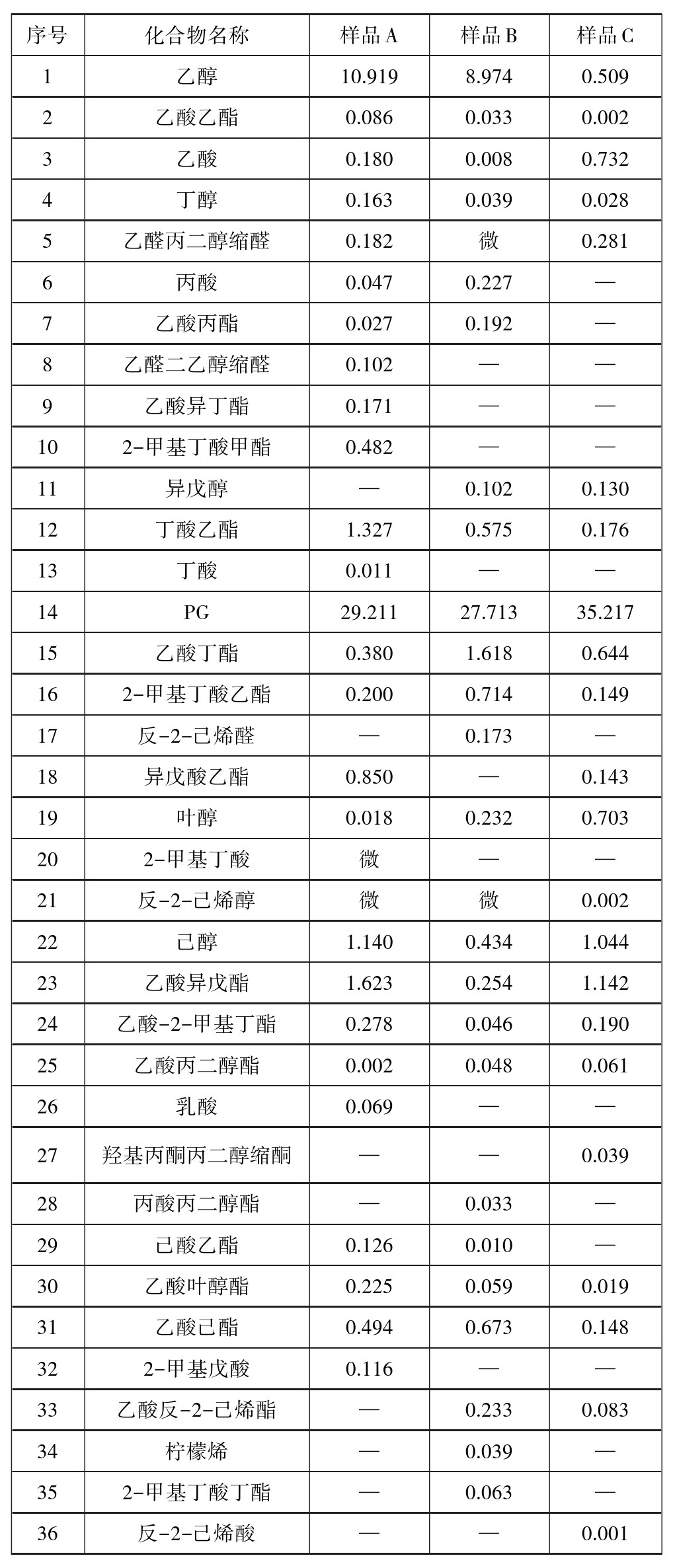
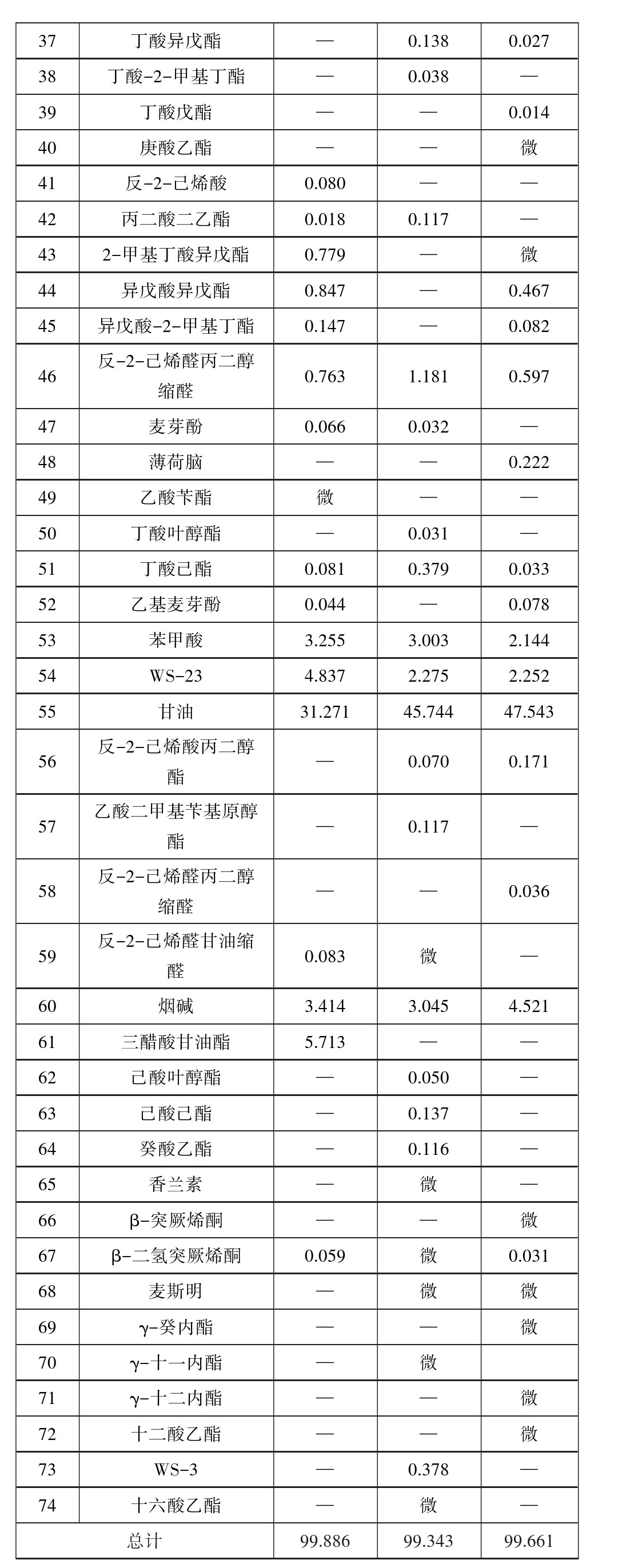
Sample A had 7 unique components (including trace amounts): acetaldehyde propylene glycol acetal, isobutyl acetate, methyl 2-methylbutyrate, butyric acid, lactic acid, trans-2-hexenoic acid, and benzyl acetate. Sample B had 14 unique components, such as limonene, dimethylbenzylcarbinyl acetate, leaf alcohol hexanoate, and hexyl hexanoate, with notable higher contents of trans-2-hexenal and WS-3. Sample C had 9 unique components, including hydroxyacetone propylene glycol ketal, menthol, and trans-2-hexenal propylene glycol acetal. Overall, the total volatile content was similar across samples, with minor differences in types and compositions.
In Sample A, 28 components exceeded 0.1% content, accounting for 99.941% of the total peak area; the top 10 by content were glycerol, propylene glycol, ethanol, triacetin, WS-23, nicotine, benzoic acid, isobutyl acetate, ethyl butyrate, and hexanol. In Sample B, 26 components exceeded 0.1%, accounting for 99.397%; the top 10 were glycerol, propylene glycol, ethanol, nicotine, benzoic acid, WS-23, butyl acetate, trans-2-hexenal propylene glycol acetal, ethyl 2-methylbutyrate, and hexyl acetate. In Sample C, 22 components exceeded 0.1%, accounting for 99.462%; the top 10 were glycerol, propylene glycol, nicotine, WS-23, benzoic acid, isoamyl acetate, hexanol, acetic acid, leaf alcohol, and butyl acetate.
Sensory Evaluation Analysis of Three Apple-Flavored E-Liquids
The sensory evaluation was performed by experienced panelists from Shenzhen Boton Flavors Co., Ltd. Vape evaluation group, with results presented in Table 2.
Table 2. Sensory Evaluation of Different Brands of Apple-Flavored E-Liquids
| Sample | Evaluation Score | Evaluation Comments |
|---|---|---|
| A | 54.8 | Green apple notes, relatively full vapor, good harmony, acceptable aftertaste; soft vapor, comfortable sweet-moist sensation, with apple sweet-sour notes |
| B | 56.1 | Green apple notes, relatively full vapor, good harmony, acceptable aftertaste; soft vapor, comfortable sweet-moist sensation, with apple sweet-sour notes |
| C | 51.7 | Apple fresh fragrance, moderate mouthfeel, average harmony, slight tongue residue |
Sample B scored highest, followed by A and C. This may be attributed to Sample B having the highest total volatile components (nearly 50), enriching the flavor profile and layering the vaping experience. Additionally, Sample B's 14 unique volatiles likely enhanced overall quality through synergistic effects.
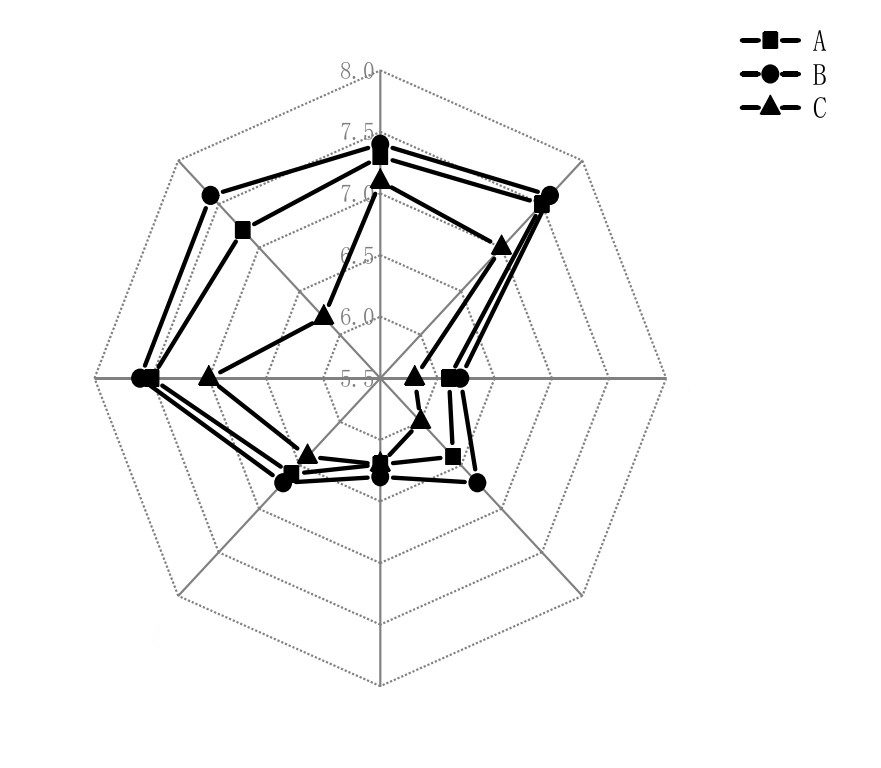
From the sensory radar chart, differences in aroma quality, throat hit, and irritation were minor, with the most significant variation in aftertaste (B > A > C), possibly due to Sample C's tongue residue. Concentration also varied notably (B > A > C), likely from Sample B's higher component diversity leading to fuller vapor. Samples A and B showed similar sensory profiles, while Sample C scored lower across all indicators, potentially due to fewer components resulting in a monotonous flavor and average harmony.
Development Approach for Apple-Flavored E-Liquids
Analysis of components exceeding 0.1% revealed that the core framework of apple-flavored e-liquids consists of glycerol, propylene glycol, nicotine, benzoic acid, and WS-23, summing to 72.070%, 82.321%, and 91.989% in Samples A, B, and C, respectively. E-liquids typically include glycerol and propylene glycol as humectants and solvents for moisturizing effects. Nicotine levels are critical for vaping satisfaction; too low fails to meet user needs, while too high may cause discomfort. WS-23, present in all samples, is a novel cooling agent offering fresh, long-lasting effects without bitterness, irritation, or spiciness, and at low dosages.
Apple aromas vary by variety, growth, and harvest, forming ester-dominant or alcohol-dominant types with fresh, pleasant, and diffusive characteristics, sometimes with subtle wine or woody notes. Literature indicates aldehydes and esters predominate in wild apple aromas, with trans-2-hexenal providing fresh elegance. Acetates like isoamyl acetate, butyl acetate, and hexyl acetate are prominent in Fuji apples; ethyl 2-methylbutyrate marks maturity as a characteristic aroma. Hexanol, leaf alcohol acetate, and ethyl hexanoate contribute significantly to small apple aromas, while ethyl butyrate, ethyl 2-methylbutyrate, 2-methylbutyl acetate, and ethyl hexanoate are key in Honeycrisp apples. Thus, the preliminary formulation included trans-2-hexenal, isoamyl acetate, 2-methylbutyl acetate, butyl acetate, leaf alcohol acetate, hexyl acetate, ethyl 2-methylbutyrate, hexanol, ethyl butyrate, and ethyl 2-methylbutyrate.
Determination of Apple-Flavored E-Liquid Formulation
Combining component analysis and sensory evaluation of the three e-liquids, a preliminary formulation was devised. Through iterative blending, vaping, and optimization, the optimal ratios were determined for aroma harmony. After multiple trials and evaluations, the final formulation is presented in Table 3.
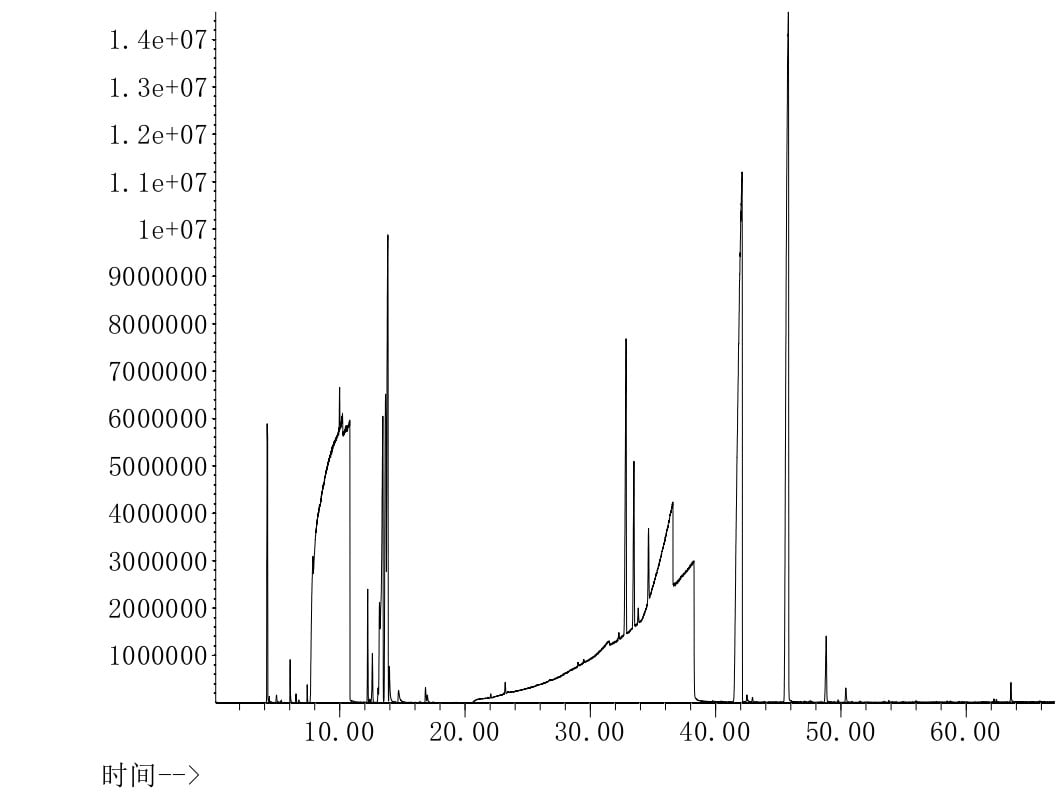
As shown in Table 3, the formulated e-liquid comprises 28 raw materials, mostly synthetic flavors to reduce production costs. The flavor profile proportions are: fruity notes 12.30%, green notes 5.70%, sweet notes 3.00%, sour notes 1.80%, fruity-floral notes 0.60%, wine notes 0.50%, cooling notes 0.20%, powdery notes 0.20%, with solvents at 70% and cooling agent at 3.00%. Vaping evaluation indicated close resemblance to apple characteristics, with green and sour apple mouthfeel, subtle banana richness and pineapple tropical fruit notes, substantial body with layering, overall harmony, and lingering aroma.
Table 3 Optimized formula of imitation smoke liquid
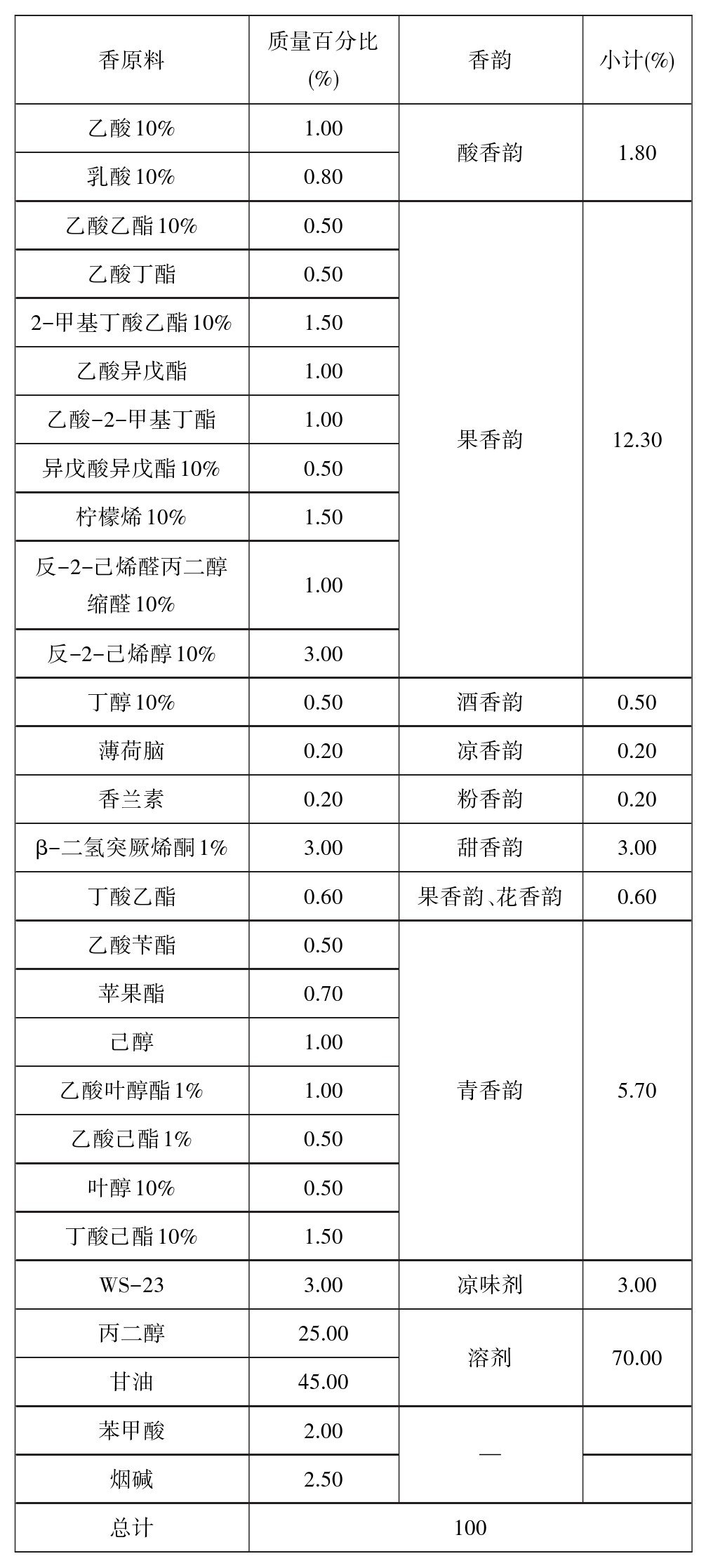
This study utilized direct injection and GC-MS to analyze volatile components in three popular market apple-flavored e-liquids, identifying 74 aroma-contributing compounds, primarily glycerol, propylene glycol, nicotine, and flavor substances. The samples shared 24 components, with notable variations in ethanol, propylene glycol, ethyl butyrate, and butyl acetate. Integrating component analysis with flavor formulation techniques, a novel apple-flavored e-liquid was successfully developed, featuring distinct green apple notes, substantial body with layering, natural rich aroma, harmonious style, and good lingering effects. These results provide valuable references for developing and formulating fresh fruit-flavored e-liquid products.
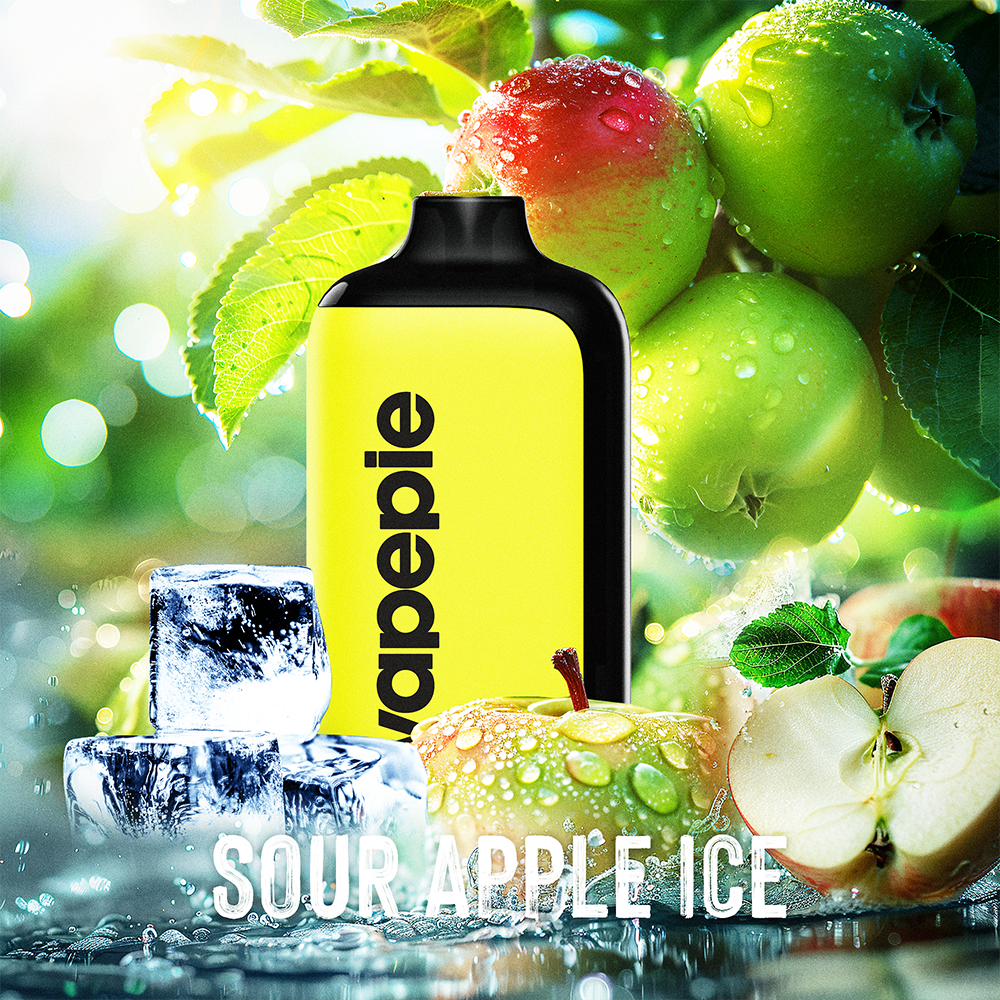
Comment